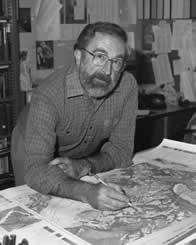

|

|
IN MEMORIAM
Professor of Geology, Emeritus
UC Berkeley
1927 – 2006
Lionel E. Weiss, a professor of geology at the University of California, Berkeley, for 33 years, died in his home in Pleasant Hill, California, on November 11, 2006, shortly after returning from a trip to England. He leaves a wife of 42 years, Liv; a son, Nicholas, and a daughter, Elin; and their children.
Lionel Weiss was born on December 11, 1927 in Cockfosters, North London, England, where he grew up and went to school. Grammar school was periodically interrupted by V1 and V2 explosions during World War II. Weiss studied geology at the University of Birmingham between 1946 and 1953. In 1948 he led an expedition to Spitsbergen to explore the previously unmapped territory of western Svalbard. In 1951 he initiated another expedition that resulted in a classical treatise on the structure and tectonics of Vestspitsbergen, the largest island in the archipelago. He then received a prestigious Commonwealth Fund Harkness Fellowship to spend from 1951 to 1953 on leave at Berkeley to work on structural geology and rock mechanics with Professor Francis Turner, visiting scholar Professor Donald McIntyre from the University of Edinburgh, and colleagues David Griggs and Hugh Heard from the University of California, Los Angeles (UCLA), work that produced a series of research papers that established Weiss’s reputation. He returned to Birmingham to receive a Ph.D. in 1953. His thesis, A Study of Tectonic Style: Structural Investigation of a Marble-Quartzite Complex in Southern California, was published in 1954 by the University of California Publications in Geological Sciences and then by the University of California Press.
MacIntyre persuaded Weiss to continue his research as senior fellow at the University of Edinburgh and, with a research grant arranged by Professor Arthur Holmes, he worked initially on the Moine Thrust in the Scottish Highlands with graduate student John Christie, who later became professor of structural geology at UCLA. He then worked in Kenya, earning a D.Sc. degree from Edinburgh in 1956.
Weiss was immediately offered a position as assistant professor of geology in Berkeley’s Department of Geology and Geophysics and returned to Berkeley in 1956. He remained there until his retirement in 1989. He taught many courses, ranging from structural geology and mineralogy to field studies. Lionel Weiss was committed to undergraduate education and was regarded as a fine teacher.
Weiss’s research focused on quantitative aspects of structural geology. He was fascinated with mechanisms of folding and developed a comprehensive theory for nucleation and growth of kink bands in rocks. On the microscopic scale he studied deformation twins in calcite and dolomite and determined preferred orientation patterns. In later years he investigated the enigmatic pseudotachylite veins that he observed in the Hebrides and Central Australia and related them to earthquake mechanisms. He approached every topic quantitatively, with experiments as well as meticulous field observations supported by theory. The results of his investigations are summarized in 30 published papers. This is not a large number; but Weiss published only what he considered important, and what he did, he completed to perfection. He also contributed as author and coauthor to four scientific books. Structural Analysis of Metamorphic Tectonites (with F. J. Turner) attracted many scientists to the emerging new field of quantitative rock deformation; The Earth: An Introduction to Physical Geology (with Berkeley colleagues) set an example of a modern treatise of geology at an advanced level that was followed by a series of books and influenced the geology curriculum; in The Minor Structures of Deformed Rocks he combined his abiding interests in both field geology and photography with inspiring artwork; the chapter on fabric symmetry in Preferred Orientation in Deformed Metals and Rocks is a paradigm of lucidity that is still a classic reference.
Professor Weiss was awarded two Guggenheim Fellowships during his distinguished career. One, in 1962, he spent in Australia with Mervyn Paterson to perform kinking experiments on phyllite. The second, in 1969, he spent with his family driving all over Europe from the North Cape of Norway to Turkey, including three winter months at the University of Basel, Switzerland. The book on Minor Structures was a result of this trip. In 1965-66 Weiss was Miller Research Professor. In 1975, as Fulbright Scholar, he returned to Norway as visiting professor at the University of Bergen. He liked to travel, realizing that the wide variety of geological features can only be appreciated in the field. Many friendships that started at the professional level developed into lasting personal relationships, as did his association with Colin Bull from Birmingham, Donald McIntyre in Edinburgh and Pomona, Mervin Paterson from the Australian National University in Canberra, and the authors of this memorial. An eminent influence on him was Francis Turner, whom he had met during his first stay at Berkeley.
Lionel Weiss met his Norwegian wife, Liv, when she came to visit her aunt and uncle, professor of mineralogy Adolf Pabst, on the occasion of a party at their home in the summer of 1964. They married later that year. The hospitality of the Weisses will always be remembered. Taking early retirement in July 1989, Lionel Weiss, with his wife, sailed the 43-foot yacht Goliard down the west coast of North America, through the Panama Canal to Florida, continuing on to the Bahamas and then along the great arc of the Lesser Antilles to Trinidad and South America, and returning to San Francisco via Venezuela and Colombia and the Panama Canal by August 1993. They both found this four-year cruise a life-defining experience. A year after returning home, Professor Weiss was diagnosed with cancer but remained active, positively focused and constructive, producing three novels and a whole library of excellent photography during his final 12 years.
Hans-Rudolf Wenk
Iris Borg
Richard Doell